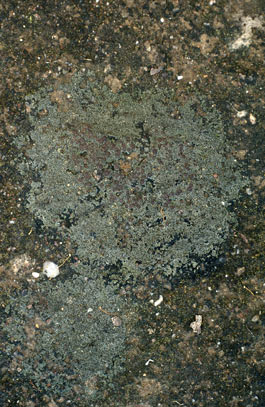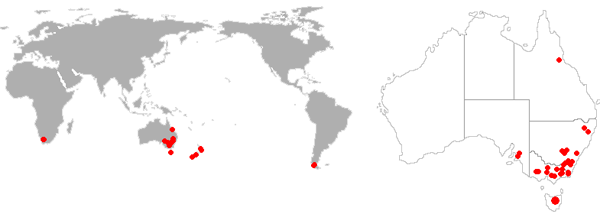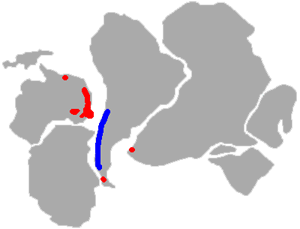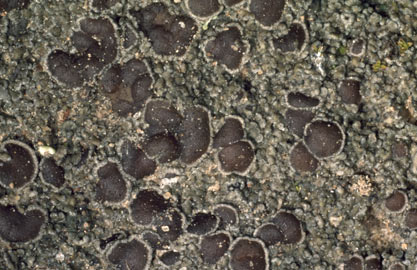
Lichen biogeography
The Fuscopannaria subimmixta story
The story of the species known today as Fuscopannaria subimmixta starts in the genus Pannaria. In the late 1800s two species of Pannaria were described, based on specimens collected in Australia or New Zealand. A description of Pannaria subimmixta, based on a specimen collected in Wellington on the North Island of New Zealand, was published by the New Zealander Charles Knight in 1880 and that of Pannaria terrestris was published by James Stirton of Glasgow in 1889 and was based on a specimen collected at Warwick in Queensland. In 1896 another description was published, this time not of a new species but of a variety of Pannaria subimmixta, namely Pannaria subimmixta var. recedens. This variant was based on a specimen collected in Lorne in Victoria and the description was published by Jean Müller of Geneva. Thus, by 1900 it appeared that Pannaria subimmixta grew in only New Zealand and Victoria and that Pannaria terrestris was a species endemic to Australia, thus far known only from Queensland. These species (and variety) were not studied again for many years and were accepted, at least by default, and so, for example, were listed in several checklists or catalogues of Australian lichens published between 1972 and 1991![]() .
.
The year 1992 saw the publication of the first lichen volume in the Flora of Australia series and included in that volume was an account of the genus Pannaria, based on a re-examination of both old and also more recently collected specimens. This was the first modern study of the Australian Pannaria species. Two of the taxonomic judgements published in that account were that Pannaria subimmixta var. recedens was identical with the species Pannaria crustata, a description of which had been published by James Stirton in 1873 and which was already known from both Australia and New Zealand, and that Pannaria terrestris was identical with Pannaria subimmixta. So, the endemic species Pannaria terrestris disappeared but the species Pannaria subimmixta was now reported from a number of sites in eastern Australia, from Victoria to Queensland. True, the Lorne collection of Müller's variety did not belong to Pannaria subimmixta, but there was other material from Victoria. Sometimes improved biogeographic knowledge comes from new specimens collected during fieldwork in previously unexplored areas, but improved biogeographic knowledge may also come from a re-examination of specimens that have long been sitting in herbaria. In the 1992 study one of the specimens examined had been collected by Reverend Francis Wilson in Victoria. There was no information about the date of collection but Wilson died in 1903 and the specimen was in a herbarium in Geneva, undoubtedly sent by Wilson to Jean Müller![]() .
.
Though the 1992 study recorded only a few Australian collections of Pannaria subimmixta, they were widespread, suggesting that the species was likely to be found in various areas between the known sites. That study also cleared up some of the confusion about the genus. The 1991 Australian lichen checklist mentioned earlier noted that 17 species of Pannaria had been reported for Australia. The 1992 study listed 13. Some of the 17 were found to be identical with others, as you've seen with Pannaria terrestris. Others of the 17 were recognized as being good species but ones that didn't belong in the genus Pannaria. So, for example, what was once known as Pannaria brisbanensis is now known as Parmeliella brisbanensis. A few of the 13 were new to Australia and had not appeared on the 1991 checklist - neither as Pannaria nor under any other guise. A clarifying publication such as that 1992 study can be an incentive for further searching in the field or for re-examination of old herbarium specimens (perhaps previously put in the 'too-hard' basket and left unidentified or identified only to genus) and the years since 1992 have seen a considerable expansion of the recorded range of subimmixta in Australia. The species grows on soil, is rather dull coloured and easy to overlook as you can see from the accompanying photo. The apothecia are about two millimetres in diameter. If you look at the photo's caption you'll see the name Fuscopannaria. Further study of the world's Pannaria species had shown the genus to be heterogeneous. In a paper published in 1994 several species were deemed worthy of a separate genus, Fuscopannaria, and Pannaria subimmixta is now known as Fuscopannaria subimmixta![]() .
.
 |
Fuscopannaria subimmixta, two thalli on the left and dark brown apothecia above (click to enlarge) |
In 2002 Fuscopannaria subimmixta was reported from South Africa and Chile. This expansion in knowledge of the species' distribution was brought about, not by new fieldwork, but by the discovery that a couple of old herbarium specimens, at Uppsala in Sweden, in fact belonged to the species. The Chilean specimen had been collected in the far south of the country in 1940 and the South African specimen had been collected in Cape Town in 1872 - close to a decade before the first published description of Pannaria subimmixta! The following maps show the known world and Australian distributions of the species![]() .
.

The changing thoughts about the biogeography of Fuscopannaria subimmixta
The pre-1992 state of knowledge, taken at face value, would have been consistent with the hypothesis of Pannaria subimmixta and Pannaria terrestris being two species endemic to Australasia and with both perhaps derived from an ancestor that had evolved in Australasia. With the publication of the 1992 study one supposedly endemic Australian species disappeared but Pannaria subimmixta was shown to be more widespread in Australia than had previously been thought. At that time the species could still be regarded as endemic to Australasia but the 2002 paper put an end to that idea and opened up new lines of thought. The distribution shown in the above world map suggests that this could be a Gondwanan species. If so where in Gondwana did the species (or its ancestor) arise?  Given that Fuscopannaria subimmixta is fairly common in what are now New Zealand and eastern Australia perhaps the species originated in that part of Gondwana that contained what later became Australia and New Zealand and what were to become South America and southern Africa were at the extremities of the species' Gondwanan range.
Given that Fuscopannaria subimmixta is fairly common in what are now New Zealand and eastern Australia perhaps the species originated in that part of Gondwana that contained what later became Australia and New Zealand and what were to become South America and southern Africa were at the extremities of the species' Gondwanan range.
The commonly presented reconstruction of Gondwana has South America, southern Africa and southern Australasia all abutting Antarctica but with Australasia abutting on the opposite side to that of the other two, as shown in the following map. Red has been used to mark the known distribution of Fuscopannaria subimmixta. In this scenario species common to Australasia, South America and southern Africa have often been attributed to dispersal across the breadth of ancient Antarctica or to the modern day distributions being relicts of wider Gondwanan distributions, so ancient Fuscopannaria subimmixta may have occurred also within the area marked by the blue ellipse, now largely under antarctic ice.
 There is an alternative reconstruction, seemingly controversial, which would leave South America and Africa joined as above but have eastern Australia against western South America. Once again the red areas in the following map mark the known distribution of Fuscopannaria subimmixta. A placement of eastern Australia against South America would readily explain the distributions of species (such as Fuscopannaria subimmixa) that are found in eastern (but not western) Australia as well as South America. Another consequence of such a reconstruction is that it immediately suggests Fuscopannaria subimmixta might today be found also within at least the area marked in blue
There is an alternative reconstruction, seemingly controversial, which would leave South America and Africa joined as above but have eastern Australia against western South America. Once again the red areas in the following map mark the known distribution of Fuscopannaria subimmixta. A placement of eastern Australia against South America would readily explain the distributions of species (such as Fuscopannaria subimmixa) that are found in eastern (but not western) Australia as well as South America. Another consequence of such a reconstruction is that it immediately suggests Fuscopannaria subimmixta might today be found also within at least the area marked in blue![]() .
.
Gondwanan origin is a plausible hypothesis but more research would of course be needed to see how well supported it is. It would be interesting also to see how close, genetically, the Australasian, southern African and South American representatives of Fuscopannaria subimmixta are and will future years show the species to be more widespread in South America or southern Africa? If not, is the species' occurrence in one or both of those locations simply the result of random, long-distance dispersal? Will the species be found in Western Australia? As with so many distribution patterns - more questions than answers at the moment.
Lichen biogeography pages on this website Distribution patterns |
![An Australian Government Initiative [logo]](/images/austgovt_brown_90px.gif)


